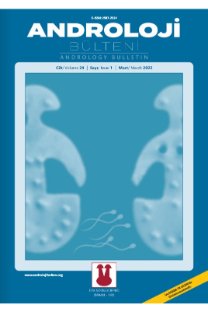Vücut kitle indeksi, testis hacmi, penis uzunluğu: Adölesan dönemi öncesi çocuklarda genel durumun yeniden gözden geçirilmesi
Body mass index, testicular volume, penile length: A review of the general situation in pre-adolescent children
___
- Wiygul J, Palmer LS. Micropenis. ScientificWorldJournal. 2011;11:1462–9. [CrossRef]
- Schonfeld WA. Primary and secondary sexual characteristics. Am J Dis Child. 1943;65:535–49. [CrossRef]
- Habous M, Muir G, Soliman T, Farag M, Williamson B, Binsaleh S, et al. Outcomes of variation in technique and variation in accuracy of measurement in penile length measurement. Int J Impot Res,. 2018;30:21–6. [CrossRef]
- Fuse H, Takahara M, Ishii H, Sumiya H, Shimazaki J. Measurement of testicular volume by ultrasonography. Int J Androl. 1990;13:267–272. [CrossRef]
- Diamond DA, Paltiel HJ, DiCanzio J, Zurakowski D, Bauer SB, Atala A, et al. Comparative assessment of pediatric testicular volume: orchidometer versus ultrasound. J Urol. 2000;164:1111–4.
- Veale D, Miles S, Read J, Troglia A, Carmona L, Fiorito C, et al. Phenomenology of men with body dysmorphic disorder concerning penis size compared to men anxious about their penis size and to controls: a cohort study. Body Image. 2014;13:53–61. [CrossRef]
- Wylie KR, Eardley I. Penile size and the ‘small penis syndrome’. BJU Int. 2007;99:1449–55. [CrossRef]
- Greenstein A, Dekalo S, Chen J. Penile size in adult menrecommendations for clinical and research measurements. Int J Impot Res. 2020;32:153–8. [CrossRef]
- Schonfeld WA, Beebe G. Normal growth and variation in the male genitalia from birth to maturity. J Urol. 1942;48:759–62. [CrossRef]
- Chung KH, Choi H, Kim SW. Penile and testicular sizes of Korean children. Korean J Urol. 1987;28:255–8. https://www.koreamed. org/SearchBasic.php?RID=1912492
- Tuladhar R, Davis PG, Batch J, Doyle LW. Establishment of a normal range of penile length in preterm infants. J Paediatr Child Health. 1998;34:471–3. [CrossRef]
- Camurdan AD, Oz MO, Ilhan MN, Camurdan OM, Sahin F, Beyazova U. Current stretched penile length: cross-sectional study of 1040 healthy Turkish children aged 0 to 5 years. Urology. 2007;70:572–5. [CrossRef]
- Cinaz P, Yesilkaya E, Onganlar YH, Boyraz M, Bideci A, Camurdan O, Karaoğlu AB. Penile anthropometry of normal prepubertal boys in Turkey. Acta Paediatr. 2012;101:e33–6. [CrossRef]
- Akyüz O. A new perspective on penis length measurement in children: How healthy are the results obtained with the current techniques? Andrologia. 2020;52:e13864. [CrossRef]
- Taskinen S, Taavitsainen M, Wikström S. Measurement of testicular volume: comparison of 3 different methods. J Urol. 1996;155:930–933. https://pubmed.ncbi.nlm.nih.gov/8583610/
- Oehme NHB, Roelants M, Bruserud IS, Eide GE, Bjerknes R, Rosendahl K, Júlíusson PB. Ultrasound-based measurements of testicular volume in 6- to 16-year-old boys – intra- and interobserver agreement and comparison with Prader orchidometry. Pediatr Radiol. 2018;48:1771–8. [CrossRef]
- Ogundoyin OO, Atalabi OM. Comparison between testicular volumes as measured with prader orchidometer and ultrasonography in Healthy Nigerian Newborns. Afr J Paediatr Surg. 2018;15:93–6. [CrossRef]
- Handelsman DJ, Staraj S. Testicular size: the effects of aging, malnutrition, and illness. J Androl. 1985;6:144–51. [CrossRef]
- Srinivas R, Thomas RJ, Sebastian T, Kurian JJ. Testicular volume in a cohort of prepubertal Indian children. J Indian Assoc Pediatr Surg. 2008;24:192–6. [CrossRef]
- Kuijper EA, van Kooten J, Verbeke JI, van Rooijen M, Lambalk CB. Ultrasonographically measured testicular volumes in 0- to 6-year-old boys. Hum Reprod. 2008;23:792–6. [CrossRef]
- ISSN: 2587-2524
- Yayın Aralığı: 4
- Başlangıç: 1999
- Yayıncı: Turgay Arık
Müslüm ERGÜN, Süleyman SAĞIR, Sule ALLAHVERDİ
Ebelik öğrencilerinde cinsel tutum ve inanışlar üzerinde cinsel utangaçlığın etkisi
Nurcan UZDİL, Yurdagül GÜNAYDIN
Mustafa Faruk USTA, Ahmet Ender CAYLAN
Artan prostat hacmi erektil fonksiyon ve yaşam kalitesi için bir risk faktörü müdür?
COVID-19 pandemisinin erkek cinsel işlev bozukluğuna ve olası etyolojik faktörlere etkisi
Alperen KURU, Taha KIR, Onur ÖZTÜRK, Uğur ÖZTÜRK, Mustafa Koray KIRDAĞ, Muhammed Emin GÖKTEPE
Penil protez cerrahisinde alternatif rezervuar yerleştirme teknikleri
Ahmet Ender CAYLAN, Mustafa Faruk USTA
Semen mikrobiatasının semen parametreleri ve erkek infertilitesi ile ilişkisi
Üremeye yardımcı tedavi yöntemleri ve etik sorunlar: Mümkün olan her şey ahlaki midir?
Adem AZ, Muhammet İhsan KARAMAN
